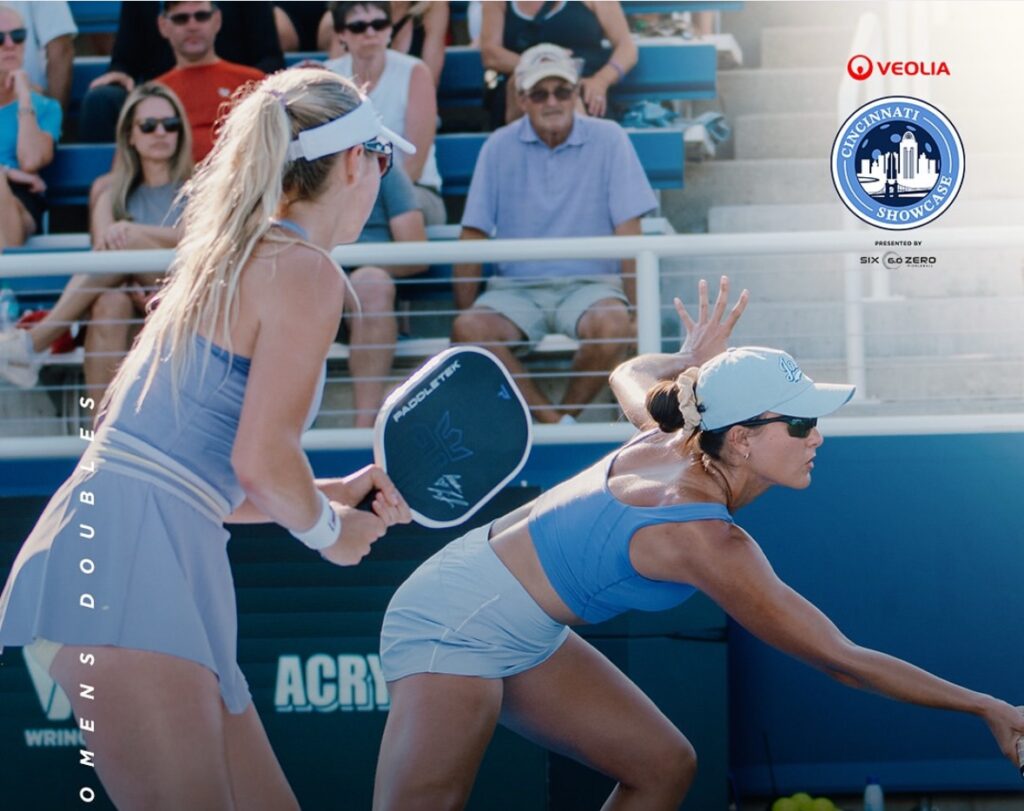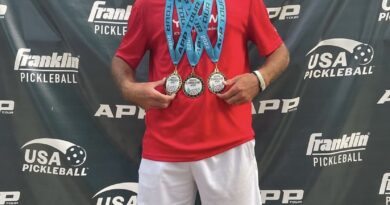PPA Tour Cincinnati Open – 3 Takeaways – Twin Tower Power

Just when you think we might have some things figured out in the pro pickleball landscape, we get thrown a couple of curve balls that reshape how we view what’s up and down. The Columbus Sliders had as epic a run as we could imagine a team having in MLP after we thought we had it sorted out that there were 4 other teams with the most realistic chance at winning an MLP title.
It was a foregone conclusion that the new Anna Bright-Anna Leigh Waters partnership would steamroll the competition for the rest of 2025. Instead, we got what felt like a post-MLP hangover loss from the Anna’s to Jorja Johnson/Tyra Black, which was followed up by another surprising loss to the Kawamoto’s in the semi-finals of a major. Unquestionably, a loss that cannot be considered in the hangover category after time to regroup and focus for the #1 team in the world.
Suddenly, we have more parity than we thought in women’s doubles and pro pickleball is better for it. Get ready for a women’s doubles heavy takeaways column!
1. Twin Tower Power – It was the first gold medals on the PPA Tour for both Jade Kawamoto and Jackie Kawamoto, which came as a bit of a surprise to us. We had assumed somewhere along the way the Kawamoto’s would have found a gold medal. They are the perpetually underrated but not really underrated, under the radar pairing in pro pickleball, and they just took gold at one of the biggest tournaments of the year by taking down the consensus top two women’s teams in pro pickleball.
They may not be the largest in stature but their presence on the court is massive. We have long thought that Tyra Black and Allyce Jones may have been the most annoying pair to play against because of how hard it is to finish a point on them, but the Kawamoto’s have to be right there with them in terms of the pure annoyance factor. The level that they played at in the semis and finals of Cincinnati was higher than anything we have seen from them before, which made their level of annoyance for their opponents that much higher.
Between Jackie and Jade, the ability to stay in points and reset their way back to neutral is second to none. Real Clear Stats provided a bunch of good information to us and one of the more astounding numbers he provided was that in the three matches the Kawamoto’s played against Bright/Waters and Johnson/Black in Vegas and Cincinnati, Jade did not miss a single third shot nor did she commit ANY unforced errors from the baseline or in transition across 8 freakin’ games.
The game of pickleball keeps evolving, but the fundamental requirements of the game that allow teams to win at the highest level have not changed. The Kawamoto’s are elite at getting to the kitchen and manipulating the ball when they get to the line to win kitchen rallies. That, along with not missing very much, enables them to mitigate their lack of elite size and power.
According to Real Clear Stats, Jackie (#2) and Jade (#5) are both top five women in terms of third shot success (i.e. getting to the kitchen or winning the rally before getting to the kitchen) using 2025 MLP data. While 48.9% of women’s doubles MLP rallies this year were kitchen rallies, the Kawamoto’s and the Anna’s had a Kitchen Rallies rate of 72.3% for their semi-final match.
In the last 3 games of the gold medal match against Tyra/Jorja, the Kawamoto’s kitchen manipulation abilities were on full display. It’s really hard to win points against Tyra/Jorja with their combined hands and high-end defense, but the Kawamoto’s are better kitchen players. It should be noted that in game 4, Tyra/Jorja actually won the kitchen rallies 17-11 over the Kawamoto’s, but they only were able to get to the kitchen 54% on their serve compared to the Kawamoto’s at 83% in game 4.
We are bringing more stats than we ever usually bring to the table, but it is fascinating to see how the data lines up with what our eyes are telling us. It remains crucial that teams get to the kitchen and when the Kawamoto’s are firing on all cylinders, they truly get there as well as any other team in pickleball. Their 78% third shot success compared to Tyra/Jorja’s 70% third shot success in the final may have been the small difference in them winning the barn burner 5 gamer.
One other aspect that gets lost between the twins is that they are not the same player. Even though they do some of the same things very well (drop, dink, defend/reset), Jade and Jackie have what seems to remain as quite essential for successful partnerships beyond twin chemistry. Relative to one another, Jade is the steadier of the pair (as noted by Jackie in their post-semi finals interview) whereas Jackie brings more aggressive kitchen play in terms of both dinking and speed-up initiation. We’ll talk about this more in our AB-ALW takeaway, but that delineation of roles may not be sorted out for the Anna’s as cleanly as it is for the Kawamoto twins. Using more stats to back this thought up, Jackie initiated 49 speed-ups in their semi-final match in Cincinnati compared to only 20 initiations from Jade.
Although, Jade brought some much needed offense to the table in games 3 and 4 of the final to flip the script of that match.
On the whole, we saw a very aggressive version of Jackie in Cincinnati and it speaks to the evolution that all players and partnerships are being forced to make with how much the game has changed. The Kawamoto’s cannot rely on their steadiness and dinking prowess alone to create opportunities in 2025. That isn’t going to win against the best teams out there. Jackie was making a concerted effort to attack in different ways and it was very much needed to keep their opponents guessing.
Having had Jackie as part of the New York Hustlers team that we drafted in 2024, we have watched a lot of Kawamoto pickleball the past two years. So, it was such a treat to watch them perform at such a high level so close to their hometown in front of friends and family. It could not happen to two more deserving and humble people to get their first gold in the most difficult way possible. Somehow, they can work full-time jobs and still beat the best players in the world who are dedicating themselves to their craft 24/7.
There is nothing more to say other than what a tremendous accomplishment this is.
2. Paddlegate – It feels like forever ago but there was a time in 2022 and 2023 where we were very vocal about the paddle problems permeating the pro game. There was all sorts of insanity going on that did not pass the sniff test. There’s no need to go back in time to review all of the history. However, as the larger, more invested in the PPA Tour companies like Selkirk and JOOLA got a free pass, it sure appeared that certain manufacturers were getting priority treatment as smaller, local companies like CRBN and Gamma were bearing the brunt of the backlash for similar issues. Grit, delamination, core crushing, lacrosse balls, freezer paddles, USA pickleball incompetence.
It hasn’t felt like things have improved all that much over the past year and a half following the merger of the PPA and MLP, and the creation of the UPA-A. Speedy interim certifications, lack of grit testing and the ongoing rapid improvement in paddle technology made it seem like the threat to the integrity of pickleball loomed large. We were skeptical that the creation of the UPA-A and the standards being formed by President, Jason Aspes, would be able to right the ship that was sailing in the wrong direction. While Aspes said all the right things and appeared to have good intentions, we didn’t trust that he would be empowered by the UPA to do what needed to be done to keep paddles in check.
However, the paddle controversy that surrounded the Cincinnati Open turned out to be the right kind of controversy for possibly the first time in paddle controversy history.
Back in January, the UPA-A announced its official Equipment Rules and Regulations that would take effect on September 1, 2025. Long story short, a bunch of paddles didn’t meet these standards by the deadline, which left a good number of pros hanging without their usual paddles at one of the PPA’s biggest events of the year. While USA Pickleball’s certification was sufficient from an interim perspective prior to September 1, 2025, that was no longer the case after September 1 as the UPA-A required paddles to meet certain established numbers for spin, power and durability.
On Championship Sunday, Jason Aspes tweeted out that of the 16 paddles in gold medal matches on that day, only Jorja Johnson’s paddle was played with in a previous tournament. “All other paddles were new to the finalists this tournament”.
In our view, that’s a giant win for the sport as it means that almost all of the paddles the best players were using prior to September 1, 2025, did not meet whatever the established standard the UPA-A carefully determined from a spin, power and/or durability perspective. We have long been proponents of limiting the power in the game and ensure the sport remains what has made it so popular to the masses. The natural evolution of the game can occur without letting paddles get out of control.
This is the first time we have felt some level of confidence that someone out there is starting to get things right. Finally, the focus is on ensuring the long-term integrity of the game rather than the short-term need for sponsorship dollars from paddle manufacturers.
There are bigger questions and concerns, particularly as it relates to USA Pickleball and whether they can get their you know what together. Paddles and paddle durability remain a problem at the amateur level, but it is encouraging to see that the current stewards of the pro game are making a concerted effort to keep things in check.
In addition, the UPA-A announced on Tuesday that it will transition to an independent, non-profit organization and the fees for paddle certification would be cut in half. What that really means from an independence perspective remains to be seen, but it is another step in the right direction, even if it ends up being more an optics thing.
Long-term, this is likely going to be a top down issue and if the most important body for the pro game leads the way on protecting the game, this should spill over to the rest of the pickleball world. Paddles are far from a solved issue but Cincinnati was a really good start.

3. How Long Will This Last? – Okay, so what’s wrong? Basically everyone thought that Anna Leigh Waters and Anna Bright would be an unstoppable duo that made the rest of the women’s doubles field play for second place. What else should we have expected when the #1 and #2 consensus best women in the game team up?
It ain’t always that easy, though. After three straight gold medals without dropping a game, the duo have come out off their tough MLP playoffs losses with back-to-back bronze medals, losing to Jorja/Tyra and the Kawamoto twins.
In hindsight, one aspect of this partnership that was underrated from a fit standpoint was how Anna Bright would fit in as a more beta role next to Anna Leigh. Although Bright was not an exclusive left-side player in women’s even with Rachel Rohrabacher, she has spent most of her pickleball career as an alpha, left-side creator.
Anna Leigh Waters is the best player in the world and probably should be on the left most of the time, but that leaves Bright on the right side in a role that she may not be 100% comfortable playing. She is a left-side creator at heart and, despite being a good mixed player, has never been a high-end creator as the female in mixed, in our opinions.
The numbers, courtesy Real Clear Stats, also seem to bear out that Bright is uncertain about what her role needs to be right now. In their Vegas loss, Bright only initiated 21 speed ups (13.8 hits per speedup) and played the left side in 43 of 101 rallies (43%) in that match. In Cincinnati, she was on the left for only 31 out of 112 rallies (28%) but initiated a whopping 44 speed ups (11.4 hits per speedup).
Interestingly, the success rate was not great in either match as she was 6-10-5 (speed ups won/lost/reset) in Vegas versus (8-12-24) in Cincinnati against the Kawamoto’s. It is unclear whether the uptick in the speed up rate was an active strategic choice from Bright and Waters, but it does seem to indicate that they are still figuring out how to optimally function together.
From what we can see, their partnership is lacking a bit of nuance right now. Rather than working the points, they are just pulling a lot and hoping their hands can figure it out. As players keep getting better across the board, the very highest level of any discipline in doubles pickleball still requires someone who is going to work the points and that may need to be more of Bright’s role going forward.
It makes it harder for Bright and Waters to figure out that patience-aggression balance as a result of the pressure of feeling like they should and need to win every match, but the reality is their partnership may need some work before they are at the point where they are unstoppable. Gabe Tardio and Ben Johns are a prime example of a duo that needed a few events to get to the point where they are at now, which appears to be the clear #1 team for now in men’s doubles.
Remember, Bright and Waters were up big in game 3 against the Kawamoto’s and it has to be such a small percentage of the time that match goes the way it did on Saturday. If they close it out after being up 9-4 in the third, we might be talking about how they righted the ship after one event blip as a post-MLP hangover.
Instead, we are questioning how long this partnership will last and whether there is a potential for a break-up in the future. If things continue to go awry, will both sides be patient enough to put in the time and effort needed to optimize the partnership? One has to think that they will given the other options available, but we have seen far crazier things happen.
We also would be remiss not to mention the MLP hangover effect and whether that has caused any dip in confidence level for either Bright or Waters. This is a brief discussion the two of us had that was mostly shot down as a nothing factor, but it still feels like it is worth throwing it out there given how the match ended against the Kawamoto’s.
At 9-8-2 in game 3 of the semis in Cincinnati, we saw Anna Leigh Waters panic in a way that we have never seen before. She went almost all the way over to Bright’s sideline to hit a mediocre forehand drive that Jackie Kawamoto countered back as a winner on Anna Leigh’s wide open left side. It was jarring to see the world’s best and clutchest player make such an ill-advised play. Waters was seen after the match potentially mouthing “I choked” to her Dad.
Anna Leigh has gone 473 days without a singles loss and won another mixed gold in straight games so there shouldn’t be much doom to this blip of a gloom on the resume.
Nevertheless, the situation is worth monitoring as this was the big risk for Anna Bright when she teamed up with Anna Leigh Waters. A possible low floor, low ceiling move for her career that could be backfiring in the short-term.
This would be the time to buy low on the Bright-Waters stock, if that was a thing you could do, but there is also real reason to believe that their stock could fall even further.
*All stats provided courtesy of Real Clear Stats.
Agree or disagree? Let us know in the comments or email us at nmlpickleball@gmail.com! You can also follow us on Twitter, Instagram and Facebook @nmlpickleball



AL asserted that her paddle was being used and was later approved, despite what Jason said
Oh interesting. Did not see or hear that